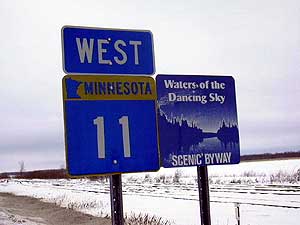Audio
Photos
Your Voice
| |||||||||||||||||||||||||||||||||||||||||||||||||||||||||||||
Minnesota's highways 'on the verge of crisis'
March 18, 2004
Business owners in outstate Minnesota say the state's highway system is on the verge of a crisis, and they're urging lawmakers to spend more money to maintain and improve highways.
Moorhead, Minn. — Driving into Warroad, Minnesota, on Highway 11, the view is dominated by Marvin Windows. The company's plant covers 45 acres of the town and employs thousands of people.
The company makes windows and doors. Getting the product out of the factory is the easy part. Shipping it to points across the country is where the process gets tough. The trucks have only one route to take.
 | |||
"Highway 11 is it," says Bob Marvin, vice president of transportation for Marvin Windows. "There isn't anything that's close or convenient for us. Our plant is physically located in the absolute worst place in the country."
Marvin says smooth roads are a must for a business that ships glass by truck. He says heavy traffic and extreme weather can be a nasty combination. If highways don't get regular maintenance, they crack, roadbeds crumble, and ruts become safety hazards.
Marvin says the company's fleet of semi-trucks drive Highway 11 to Interstate 29, 100 miles to the west. He says weight restrictions prevent the trucks from using other roads, and rail service is an unreliable option. Marvin says many companies in northern Minnesota face the same problem.
"There's International Paper Co. in International Falls, there's Solvay Pharmaceuticals in Baudette, 30 miles away," says Marvin. "Polaris, in Roseau 20 miles away, and Arctic Cat 80 miles away."
All of those companies depend on Highway 11 to move product in and out of their plants. The two-lane highway gets a lot of traffic.
 | |||
"If I recall correctly, Polaris has got like 200-some trucks coming and going every day, in and out of that plant," says Orris Rasmussen, chair of the Roseau County Commmission.
Rasmussen spent 36 years working for the highway department. He says roads with that much traffic take a pounding.
"Every truck on the road -- a loaded truck -- is equivalent to 2,700 cars driving that same length of road," says Rasmussen. "So you can see the damage that the trucks do."
Rasmussen says the county will receive $3 million from the state this year for road repair and construction -- the same amount the county got last year.
"But the cost of construction is skyrocketing, and that's where we've got a big problem. We're just going to do with less," says Rasmussen. "But there's going to come a time when there's going to be roads that aren't going to be taken care of, and that's approaching right now."
Rasmussen says the county budget is tapped out -- there's no more local money available for roads. He says it's up to the state, and says state officials need to raise the gas tax.
 | |||
Sen. Keith Langseth, DFL-Glyndon, agrees it's time to raise the gas tax.
"We have not had one (a gas tax increase) for 16 years. I think there is only two states in the United States that have not increased their gas tax since we have. We simply have to get more money into the system," says Langseth. "A nickel gas tax will raise a $160 million a year. The Senate has passed it year after year after year. The House will not go along with it, and the governor will not go along with it."
Langseth says roads in rural areas are vital economic links. He says there are also safety issues to consider.
"Seventy percent of the fatalities are in rural Minnesota, on rural two-lanes. Upgrading these two lanes to the point where they are what we call 'super-twos,' with the turning lanes and so on, (needs to be done)," says Langseth. "Most of those deaths occur on intersections. You can save a lot of people's lives by upgrading those two-lane highways."
Langseth says the longer lawmakers wait to address the issue, the more expensive it will get to fix the problem. For a company like Marvin Windows, roads like Highway 11 seem to be as fragile as the glass products they ship.
|
News Headlines
|
Related Subjects
|


